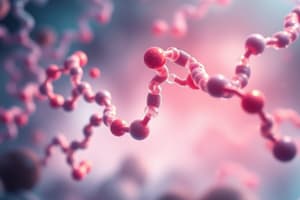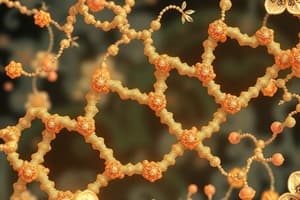Podcast
Questions and Answers
What functional groups are present in amino acids?
What functional groups are present in amino acids?
- Amino and hydroxyl groups
- Amino and carboxyl groups (correct)
- Hydroxyl and carbonyl groups
- Carboxyl and sulfhydryl groups
What distinguishes L-amino acids from D-amino acids?
What distinguishes L-amino acids from D-amino acids?
- Their configuration relative to D-glyceraldehyde (correct)
- The number of peptide bonds formed
- The presence of an additional amino group
- The type of side chain attached to the alpha carbon
Which ion predominates at pH 7 for amino acids?
Which ion predominates at pH 7 for amino acids?
- Neutrally charged molecule
- Carboxylate anion (correct)
- Cation
- Dication
What is the role of the side chain group (R) in amino acids?
What is the role of the side chain group (R) in amino acids?
Which of the following best describes a peptide bond?
Which of the following best describes a peptide bond?
Which property allows amino acids to act as both acids and bases?
Which property allows amino acids to act as both acids and bases?
What is the significance of the three-dimensional structure of amino acids?
What is the significance of the three-dimensional structure of amino acids?
Which statement is correct regarding the stereochemistry of amino acids?
Which statement is correct regarding the stereochemistry of amino acids?
What is formed when an amino acid is in its zwitterion form?
What is formed when an amino acid is in its zwitterion form?
Which amino acids are exclusively found in connective tissue proteins like collagen?
Which amino acids are exclusively found in connective tissue proteins like collagen?
At neutral pH, which form do free amino acids tend to exist in?
At neutral pH, which form do free amino acids tend to exist in?
What characterizes the titration curve of alanine?
What characterizes the titration curve of alanine?
Which statement is true regarding amino acids without charged side chains?
Which statement is true regarding amino acids without charged side chains?
What happens to an amino acid's structure when it is titrated?
What happens to an amino acid's structure when it is titrated?
What is true about the cationic form of an amino acid?
What is true about the cationic form of an amino acid?
What distinguishes histidine from standard amino acids during titration?
What distinguishes histidine from standard amino acids during titration?
What does the isoelectric pH (pI) represent for a molecule?
What does the isoelectric pH (pI) represent for a molecule?
How is the isoelectric pH (pI) calculated for glycine?
How is the isoelectric pH (pI) calculated for glycine?
What is the calculated pI for aspartic acid?
What is the calculated pI for aspartic acid?
At low pH, which amino acid is most likely to have a net charge of +2?
At low pH, which amino acid is most likely to have a net charge of +2?
What is the pI calculated for lysine?
What is the pI calculated for lysine?
What is the pI for glutamic acid based on the provided values?
What is the pI for glutamic acid based on the provided values?
Which of the following amino acids is likely to have a net charge of -2 at high pH?
Which of the following amino acids is likely to have a net charge of -2 at high pH?
Which equation is used to calculate the pI for basic amino acids?
Which equation is used to calculate the pI for basic amino acids?
Which amino acids are classified with basic side chains?
Which amino acids are classified with basic side chains?
What is the pKa of the side-chain imidazole group of histidine?
What is the pKa of the side-chain imidazole group of histidine?
What is the ratio of uncharged to charged side chains of histidine at pH 7.0?
What is the ratio of uncharged to charged side chains of histidine at pH 7.0?
Which of the following amino acids has a nonpolar side chain?
Which of the following amino acids has a nonpolar side chain?
Which amino acid contains a guanidino group in its side chain?
Which amino acid contains a guanidino group in its side chain?
Why is serine not classified as having a basic or nonpolar side chain?
Why is serine not classified as having a basic or nonpolar side chain?
Which amino acids share a structural parent with distinct derivatives?
Which amino acids share a structural parent with distinct derivatives?
Which of the following statements about basic amino acids is accurate?
Which of the following statements about basic amino acids is accurate?
Which amino acid is unique because it does not have a chiral center?
Which amino acid is unique because it does not have a chiral center?
What is the typical configuration of most alpha-amino acids at the alpha-carbon?
What is the typical configuration of most alpha-amino acids at the alpha-carbon?
Which of the following amino acids contains a sulfur atom in its side chain?
Which of the following amino acids contains a sulfur atom in its side chain?
Which characteristic is NOT associated with the amino acid proline?
Which characteristic is NOT associated with the amino acid proline?
In amino acids with nonpolar side chains, which of the following amino acids is categorized as aromatic?
In amino acids with nonpolar side chains, which of the following amino acids is categorized as aromatic?
Which of the following amino acids is NOT classified as nonpolar (hydrophobic)?
Which of the following amino acids is NOT classified as nonpolar (hydrophobic)?
Which amino acid is typically represented by the one-letter abbreviation 'W'?
Which amino acid is typically represented by the one-letter abbreviation 'W'?
Which term is used to denote the first carbon in the side chain of amino acids?
Which term is used to denote the first carbon in the side chain of amino acids?
Study Notes
Amino Acids Overview
- Amino acids consist of an amino group (—NH2), a carboxyl group (—COOH), and a side chain (R) attached to the α-carbon.
- Most amino acids in proteins are L-amino acids, which are chiral and have a specific stereochemistry akin to L-glyceraldehyde.
- Glycine is the only amino acid without a chiral center.
Structural Properties of Amino Acids
- All amino acids except glycine exhibit chirality with at least one chiral center at the α-carbon.
- Amino acids are frequently categorized by side chains into nonpolar, polar, acidic, and basic groups.
- Common abbreviations for amino acids follow either three-letter or one-letter formats.
Classifications of Amino Acids
- Nonpolar amino acids (hydrophobic) include: glycine, alanine, valine, leucine, isoleucine, proline, phenylalanine, tryptophan, methionine.
- Basic amino acids with positively charged side chains at physiological pH (near 7) include: histidine, lysine, and arginine.
- Amino acids with nonpolar side chains include alanine, leucine, and phenylalanine; histidine and lysine are categorized as basic.
Titration and Zwitterions
- Amino acids act as both acids and bases, exhibiting zwitterionic forms at neutral pH—carboxyl groups carry a negative charge, while amino groups carry a positive charge.
- Neutral amino acids exist as zwitterions and have no net charge.
- The titration curve of an amino acid demonstrates how its functional groups react with hydrogen ions, culminating in the determination of isoelectric point (pI).
Isoelectric Point (pI)
- The pI is the pH at which a molecule has no net electrical charge.
- The formula for calculating pI is:
- pI = (pKa1 + pKa2) / 2, applicable for simple amino acids.
- For glycine, the pI is approximately 5.97, derived from its carboxyl (pKa ~2.34) and amino (pKa ~9.60) groups.
Uncommon Amino Acids
- Some posttranslational modifications yield uncommon amino acids, such as hydroxyproline and hydroxylysine found in collagen.
- Thyroxine is derived from tyrosine and is specific to the thyroid gland.
Examples of Titration & pI Calculations
- Example calculation for aspartic acid shows a net charge of -2 at high pH and the use of pKa values to establish pI.
- pI for basic amino acids like lysine is calculated by averaging the pKa of their basic side chains.
pKa Values
- A variety of amino acids have distinct pKa values, guiding their behavior in biological systems.
Charged vs. Uncharged State Ratios
- The ratio of charged to uncharged side chains, particularly for histidine with a pKa of 6.0, indicates that at pH 7.0, the ratio is approximately 10:1.
These notes encapsulate the essential characteristics and biochemical significance of amino acids and their roles in proteins.
Studying That Suits You
Use AI to generate personalized quizzes and flashcards to suit your learning preferences.
Related Documents
Description
Explore the key concepts of amino acids and peptides in this quiz based on Chapter 3. It covers the three-dimensional structures, properties of amino acids, peptide bonds, and the physiological activities of small peptides. Test your understanding of these fundamental biochemical elements.




